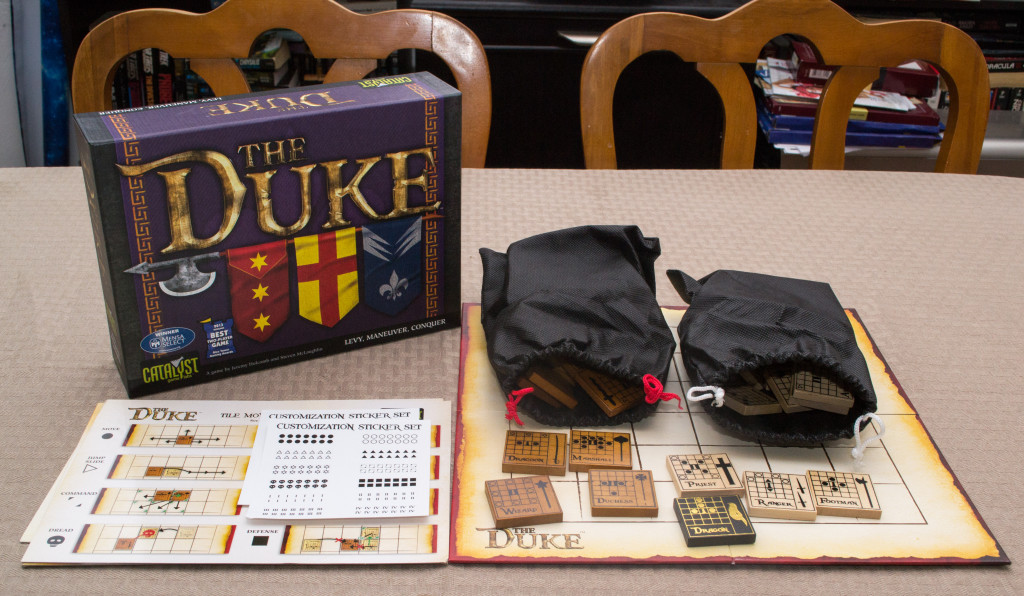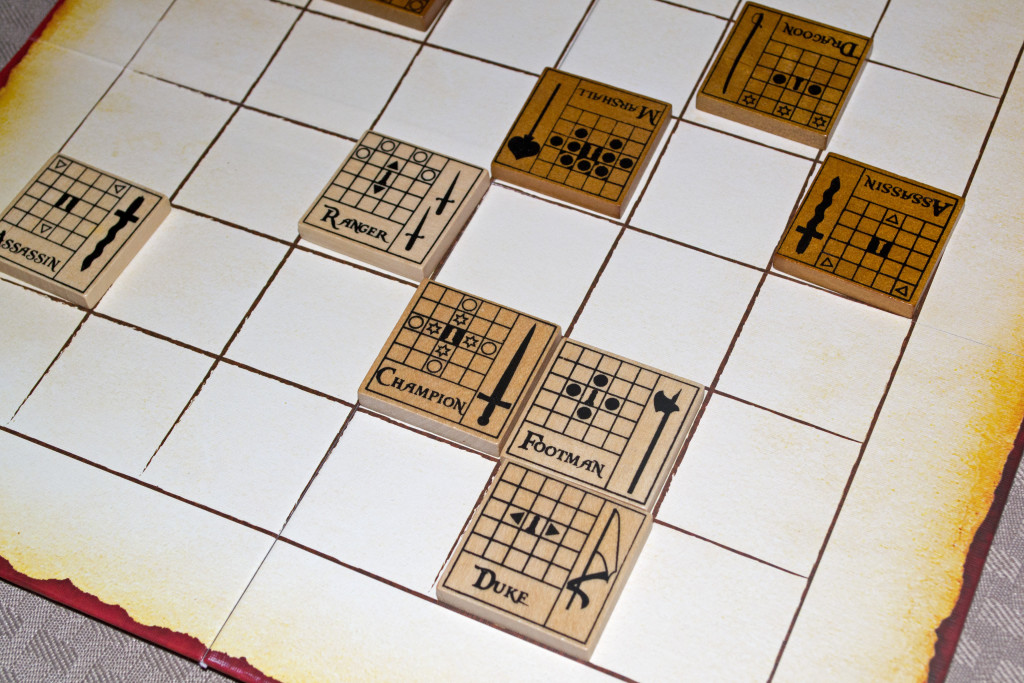“Chess” is a prime example of a strategy game that will test not only your critical thinking skills but your ability to make the most out of a bad situation. Don’t simply take my word for it…a quick “Google-search” will tell you that the game dates back over 1,500 years (and yes, people are STILL playing it). Now, if “Chess” had a modern-day counterpart, I’d have to say that “The Duke” is a strong contender, even if it plays slightly different then what “Chess” players are used to. Before I get into specifics, I’d like to quickly thank Managing Developer Randall Bills from Catalyst Game Labs for providing me with a free press copy for review purposes.
Components
1 Game Board, 2 Bags, Terrain Tiles, Troop Tiles, Enhanced Tiles, Customization Tiles, a Rulebook, and Reference Cards
Setup & Gameplay
Each player will choose one bag of troop tiles and place their “Duke” on one of the two center squares on their edge row (the two Duke tiles must also be on opposite center squares). Players can then place two “Footman” tiles in such a way that they are adjacent (horizontally or vertically) to the Duke. Since troop tiles are two-sided, it’s important that players flip them to the side with the appropriate “starting side” (the inverted pawn is the non-starting side). There are some other ways players can customize their setup (removing troop tiles with enhanced abilities, including terrain and/or dragon tiles, etc.), but to keep the review moving, I’ll opt to cover the rules from the standard game.
On a player’s turn, they may do only ONE of the following:
1. Move a Troop Tile – The player may move a tile according to the movement rules listed on it. After movement is complete, the tile is flipped to the other side. It’s important that players pay attention to the symbols on the tile’s grid to determine what they can do (jump, move any number of spaces in a particular direction, take a piece without moving, etc.). If a player lands on an enemy piece (or “strikes” it from afar), they may remove it from the board. If a player should move in such a way to where the enemy Duke is under attack, they must say “Guard”.
2. Place a New Troop Tile – The player may pull a random tile from their bag and place it on an unoccupied square adjacent to their Duke.
3. Use an Enhanced Ability (optional) – Some tiles have special abilities that can be used while they are in play. Including these tiles in your game are optional.
Players continue taking turns until one player captures the other player’s Duke (similar to a “checkmate”)…whoever does so, wins the game!
Editor’s Note: The above doesn’t cover all of the rules found in the manual, but should give you an idea as to how the game is played. For more information, you can check out the manual here:
http://www.catalystgamelabs.com/download/The%20Duke%20Rulebook%20Lo-Res_FINAL.pdf
The Review
Firstly, I want to commend the game for having so many different ways to play (aside from the core rules). Most common are the tiles with enhanced abilities like “Summon” and “Divination” that really change the way you’ll think about some of the pieces. “Terrain” tiles can also be added onto any open square during game setup to limit piece movement and alternatively, “Fort” tiles can be added to help players block any ranged “strikes”. Then you’ve got “Dragon” tiles, “Flag” tiles, and gameplay modes with alternative objectives…trust me, you won’t be bored with this game. I highly recommend however that you get used to the core rules first before implementing any of the extra content/rules.
Speaking of the core game, there’s a lot going on here. Part of the challenge with games like “Chess” is getting used to how the pieces move and I found myself in the same boat here. “The Duke” takes this to a whole new level by including an alternate way of moving on the reverse side of the troop tiles…meaning that once you move and flip a tile, you’ll be presented with a different movement rule set. In other words, what that piece may have done on a previous turn may not be what it is capable of doing on its next turn. Thankfully, each tile lists its movement rules and further, players may even look at their troop tiles’ reverse sides on their turn to refresh their memory. This presents players with all new strategies to plan for and try out…I couldn’t imagine what “Chess” would be like if the Rook could suddenly move like a Knight during the game!
Normally I’d take issue with the $35 price tag (seeing as how some “Chess” sets can be bought for about ten bucks), but a number of things stand out here that’s worth some consideration. Firstly, the tiles themselves are made of wood and of fairly good quality. Secondly, the game includes a number of different ways to play and includes alternate objectives in the rulebook. Finally, there are customization tiles and sticker sheets available for players to create their own & unique custom armies. Where “Chess” is a game with one primary way to play, “The Duke” is almost a full-blown kit. To me, these features add tremendous value and make it easily recommendable to those who love strategy games. Further, there are two expansions (links below) for those who want to expand their game further.
“The Duke”, hands down, is one of the best “Chess” games that I’ve had the pleasure of playing over the course of my lifetime.
Final Verdict: 10/10
—



Thanks for review. It’s a good game